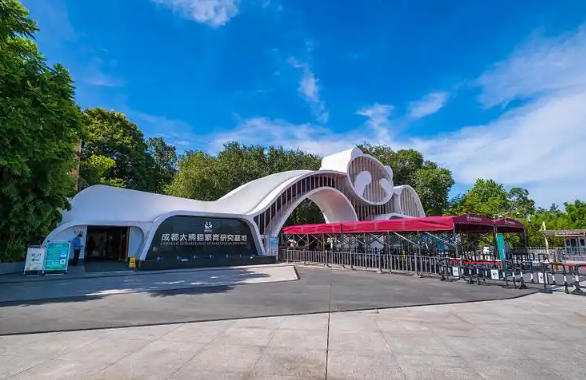Chengdu Research Base of Giant Panda Breeding is one of the world’s most famous and important institutions for giant panda conservation and research, and a top attraction that tourists to Chengdu must hit. It is not only a zoo, but also a comprehensive conservation base that integrates scientific research and breeding, public education, international exchange and eco-tourism.
Core Highlights and Values:
The global flagship giant panda conservation center:
It is the world’s most numerous and technologically sophisticated base for the artificial breeding of giant pandas, and has made world-renowned contributions to saving the endangered species.
Many panda cubs born overseas have parents from here.
It is a window to understand the cause of giant panda conservation and witness China’s achievements in endangered species protection.

Immersive viewing experience:
Simulated wildlife ecosystem: The base covers a vast area (over 100 hectares) and is not a traditional caged facility. Giant pandas live in an environment that mimics their natural habitat, with large bamboo forests, trees, hillsides, streams and grasslands.
Close Observation: Visitors can observe the pandas’ natural behaviors: eating bamboo, sleeping, playing, climbing trees, and playing at a relatively close distance (of course, with safety precautions) through the well-designed trails and viewing platforms. The simplicity of the pandas is infectious.
Pandas of all ages: Adult pandas, sub-adult pandas and, most popularly, giant panda cubs can be seen (especially in the maternity ward area).
Core must-see areas:
Moon Maternity & Sun Maternity Rooms: The most important area! This is where the newborn panda cubs and their mothers live. You can see the pink, “sticky rice ball” panda cubs in their incubators or being cared for by their mothers. This is the most crowded area of the base, but also the one not to be missed.
Giant Panda Villa Area: The main activity area for adult and sub-adult giant pandas, where they can usually be seen leisurely eating bamboo or sleeping. The environment is beautiful and spread over different hills.
Giant Panda Activity Areas: Some open spaces where pandas may play or explore.
Giant Panda Enchantment Theater/Scientific Mystery Hall (optional): Learn more about the biology of giant pandas, their conservation history and the base’s scientific research through films or panels.
Red Panda Activity Ground: Don’t forget that there are also cute red pandas (red pandas) living here, which are also a Grade 2 protected animal and often move around in the trees, with their big fluffy tails. (Note: Red pandas and giant pandas are different species!)
Panda Tower: A newer landmark with a panoramic view of the base.
Key information for your visit:
Address: 1375 Panda Avenue, Chenghua District, Chengdu, Sichuan Province.
Transportation:
Scenic Area Bus: One of the most convenient ways to get to the south gate of the base is to take a bus from various locations in the city (e.g. Chunxi Road, KuanNarrow Alley, Wuhou Temple, etc.).
Metro + Bus: Take Metro Line 3 to the “Panda Avenue” or “Military General Hospital” station and transfer to the scenic area shuttle bus (usually clearly marked).
Taxi/Internet car: 40-60 minutes from the city center, costing around 50-80 RMB.
Opening hours:
High season (usually around April-October): 07:30 – 18:00
Low season (usually November – March): 08:00 – 17:00
It is highly recommended to check the official website or official public number to confirm the latest hours before departure!
Tickets:
Adult Ticket: about 55 RMB (Prices may be adjusted slightly, please refer to the official website).
Discounted tickets are available for students/seniors, etc.
It is strongly recommended to book tickets in advance on the official platform (WeChat public number “Chengdu Research Base of Giant Panda Breeding” or cooperative platforms)! Especially during holidays and peak seasons, the flow of the site may be limited or tickets may not be available.
Visiting time: 3-5 hours is recommended. The base is large and requires a lot of walking (there are also sightseeing buses available for a fee).
Super useful tour tips:
Early in the morning! Early! Early in the morning!
Best viewing time: morning! Giant pandas are morning and evening animals, and are most active in the morning (especially before 9am): eating breakfast, playing and moving around. Most of the time from noon to afternoon is spent sleeping (although the sleeping look is also very cute).
Go early to avoid the crowds: the earlier you go, the fewer the crowds and the better the experience. go in at 7:30 and go straight to the moon maternity ward/sun maternity ward! If you’re late, there will be long lines.
Route Planning:
Core Goal: After entering the park (the south gate is the closest), go straight to the Moon Maternity Ward and the Sun Maternity Ward (these two are usually next to each other, read the signs). After seeing the cubs, take your time to stroll around the adult panda villa area and other areas.
Sightseeing bus: If you don’t want to be too tired or have an elderly child with you, consider buying a ticket for the sightseeing bus (about 10-30 RMB, the route is not